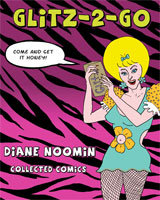
Diane Noomin's comics cover quite a bit of territory, from the broad (ha, ha) farce of her Didi Glitz stories to penetrating social satire and revealing autobiography. At her best, such as in her harrowing story of multiple miscarriages discussed below, she manages to combine all of the above approaches to devastating effect. This story alone makes this collection worth reading.
I interviewed Ms. Noomin for Hypno Magazine in 1995 via telephone, and later met her in person at the San Diego Comic Con. She had just finished editing a new series of Twisted Sisters comics, her influential anthology of female cartoonists, and was finalizing the collected volume, Twisted Sisters 2: Drawing the Line, so she was busy indeed. Later, the magazine came out and the interview was so obnoxiously designed (a Hypno trademark) it looked like a computer had had a nervous breakdown, so I'm re-typing it here rather than subjecting you to ugly scans. The interview follows:
PH: You just finished both editing and contributing to the new Twisted Sisters anthology for Kitchen Sink Press. Was that a tough juggling act?
DIANE NOOMIN: Yes, it was really tough. It's really hard to be an editor of your peers and a cartoonist at the same time. I had to wear a lot of different hats. It was hard, especially, since the first Twisted Sisters was work that had already been in print, so it was just a question of finding stuff I liked and getting permission to use it. There was a lot of work involved, but I didn't have to worry about hassling people about deadlines, or someone deciding that they wanted to do twelve pages instead of ten, or someone deciding to do only three pages when they had promised ten. There were more immediate and pressing problems... dealing with people's personal lives and trying to be sympathetic. I think I was somewhere between a den mother and a drill sergeant.
PH: Mary Fleener affectionately referred to you as an "editress," but also as a Jewish Earth Mother.
DN: [laughs] I don't know if that's about my hips, or what! I guess I'll take it as a compliment.
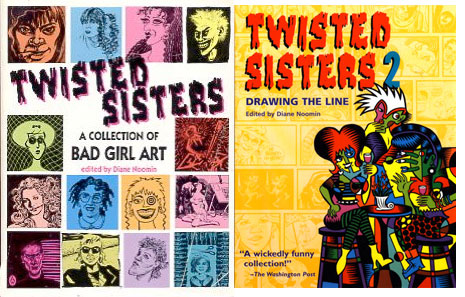
PH: Your new long story, "Baby Talk", is an excruciatingly personal tale of multiple miscarriages. Was it a cathartic experience to write it?
DN: At times it was. I may not know for a while, because I just finished it, and I'm still pretty close to it. I think that one of the reasons I did it was that I was hoping it would be a cathartic experience. It's interesting, because you find yourself choking up and getting really emotional about something, and then the artist part of you jumps in and says, "Great! I can use that!" There are a lot of powerful emotions involved, but you have to figure out how to not just vomit it out on the page, but turn it into something that people will respond to and want to read.
PH: Was it difficult to inject humor into that story?
DN: Surprisingly, it wasn't that difficult. I was worried about that. I really don't want to do something that people would think, oh, this is a whining story, and who cares, and it's just another story about women's bodily functions. I was really concerned about that. The humor came in when I decided to use Didi Glitz, with these intervals of me and Didi talking. That was a natural source of humor, and that was really fun for me and sort of a needed break.
PH: In the story, you begin with a fictional couple, and then Didi Glitz gets fed-up and literally pulls you from behind that mask and forces you to tell your own story, honestly, without fictionalizing it. Was that planned originally?
DN: [laughs] It wasn't planned. Actually, the story behind "Baby Talk" is that I tried to do that story off and on for a long time, and I think I had the first page-and-one-half for about five years, and I couldn't do it. I just couldn't face it. I wasn't really ready to do the story and deal with the subject of miscarriages. In fact, the subtitle of the story is "A Tale of [3 crossed out] 4 Miscarriages".

PH: Because in the meantime, since starting the story, you had...
DN: Another miscarriage. Finally, I knew it was what I wanted to do for the new Twisted Sisters, but I didn't want to do it the same way. I first wanted to do it indirectly, hiding behind Didi's sister as my fictional stand-in. I didn't want to do it that way anymore, but I didn't want to scrap the work I'd already done! [laughs] I did have some doubts and fears about coming out from behind the mask as well, so I incorporated that, too.
PH: It certainly makes the story more complex, narratively, than your earlier work.
DN: Well, it's fun. It's fun to play with that, the whole notion of being a cartoonist and "how real is your cartoon character?"
PH: It's amazing that you're telling this horrifying tale to Didi Glitz while doing her hair and painting her toenails!
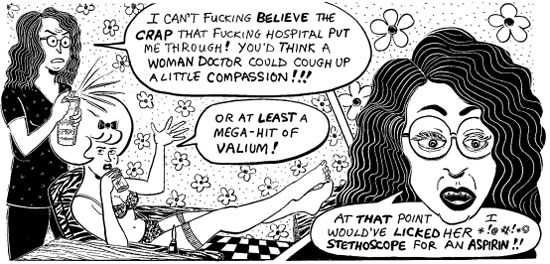
DN: Well, that's what I meant by breaking it up!
PH: It does, but it doesn't take away from the immediacy of the story, which is tremendously affecting.
DN: I'm glad. It was a very tricky juggling act to deal with something so personal and horrific, and turn it into something that people will want to read.
PH: Let's talk more about Didi Glitz. She's been around for roughly twenty years now. Can you tell me something about her origin?
DN: It's sort of complicated. The first Didi story appeared in Wimmen's Comix [Last Gasp, 1974], and it was "She Turned to Crime," where Didi robs a bank and goes to Rio. [laughs] I think she started out as a Halloween costume. I had this bubble wig and leopard skin outfit. I had a roommate at the time, Willie Murphy, a cartoonist, who called me Didi. It's really based on living in Brooklyn in the early 60s.
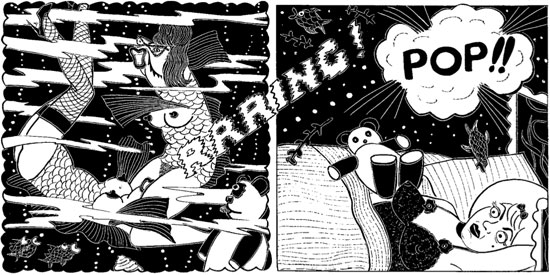
PH: Is Didi Glitz an alter-ego, or more of a foil to your personality?
DN: That's sort of complicated. She's an alter-ego in that she's very brash, and there's certainly a part of me that would have liked to stay in Brooklyn and eat bagels for the rest of my life. Didi is definitely very real, and a part of me, but she's also a way to create satire and comment on certain types of people, and women's roles and all that stuff.
PH: Is that Nancy's bow on Didi's head?
DN: I never thought of that! [laughs] It looks like it could be. It's rigid enough.
PH: What's in a Golden Cadillac, Didi's favorite drink? Do you like them?
DN: It's Galliano, Triple Sec, and cream. Not bad as far as festive beverages go.
PH: How about Mai Tais? Didi guzzles plenty of those, too.
DN: Mai Tais are good. I like large drinks in coconut shells with umbrellas and pineapple. I go for trimmings.
PH: How have you and your husband influenced each other? I noticed your swipe from his Zippy book Are We Having Fun Yet [Dutton, 1985] in your "I Had to Advertise for Love." [Young Lust, 1990]
DN: He did that earlier?
PH: Yes, the exact same pose (see below, Noomin on the left, Griffith on the right):
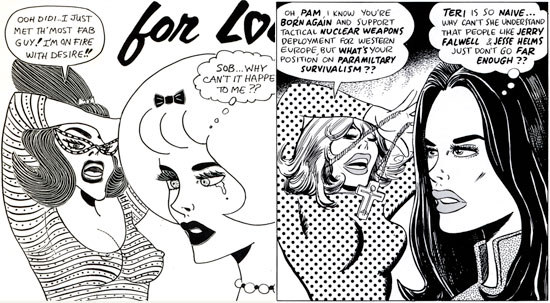
DN: Hmmm. I'll have to look it up.
PH: It wasn't intentional?
DN: No... that must be a subconscious influence.
PH: Well then, I guess that's a good example of how you influence each other!*
DN: Also, when we started going out, Bill was already an established cartoonist, and he took it real seriously, and he was at the drawing board being a complete workaholic, so just having someone around who was drawing all the time was a big influence on me getting serious about it.
PH: Bill drew himself in "Baby Talk", and Didi made guest appearances in Zippy. Are you two planning on any further collaborations?
DN: We're not really planning anything. I guess sometimes it just happens. I asked him to do that in "Baby Talk". It just seemed like the right approach, because it was such a personal story, and it was his story as well. I did tell him what to draw and what to say! [laughs]
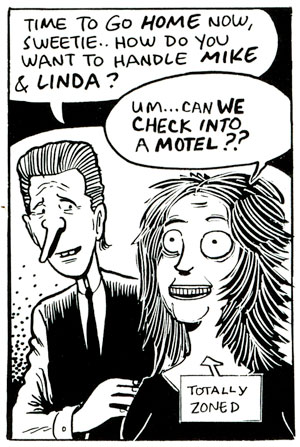
DN: But in terms of influencing him, I'll just say what I think, and if he wants to... Neither one of us are super great at taking criticism. You sort of pout for a while, and think about what they said, and end up changing it. We worked on the screenplay together for the Zippy movie.
PH: Ah, yes, the Zippy movie...
DN: On that level, I got very involved with his work. I was writing the screenplay with him, and it was his characters, so that was very interesting. It's gone off and on for, I don't know, nine years or something.
PH: Do you think it will ever get made?
DN: I have no idea. It's possible. We've had many entertaining Hollywood meetings. At this point, I'm very skeptical.
PH: Is Didi Glitz in the screenplay?
DN: No, I wouldn't want to do that. I wouldn't want to throw it away. I have plans for her.
PH: Would you ever attempt to do a daily strip?
DN: I actually tried that for about a week-and-a-half, and I thought I'd have a nervous breakdown. It's very difficult. Just sitting there and having that pressure. It's kinda like writing a Zen haiku each time.
PH: At least it should be, unlike most daily strips.
DN: Unlike Marmaduke! [laughs]
PH: You mentioned earlier an affection for Family Circus.
DN: Well, it's grown on me. It's very surreal. Bill showed me a recent one where one of the kids was imagining himself as an old man, and he had a beard, but he still looked exactly the same!
PH: Your work, on the other hand, is often very sexually graphic. Any comments?
DN: It's kind of liberating the first time you do that; you sort of shock yourself, and then it's kinda fun.
PH: You get pretty extreme, what with Didi and her poodle!
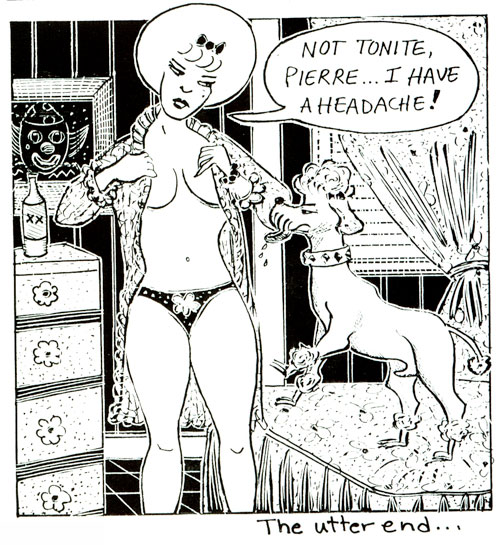
DN: That's part of the fun, to take it as far as you can. When you think about Didi, and you think about poodles, it's not all that unlikely.
PH: Do you consider yourself a feminist?
DN: I consider myself a feminist. Certainly there are people who won't, but I'm a feminist and I think it's good to do sexual material, and make fun of sex, and not think that there are certain bodily functions that we shouldn't talk about because we're feminists. I think that's... fucked up. I believe in the First Amendment extremely, and there are lots of things in print that I don't like, and I think are horrible... but there are a lot of people who don't like my work, and don't want to see it in print.
PH: Did you get any flack for "Lesbo a Go Go", in which Didi is seduced by a lesbian, and it all turns out to be a cruel trick?
DN: No. [laughs] I didn't. I've had people ask, "How come there are no lesbians in Twisted Sisters?" and my first reaction is, well, how do you know there aren't? My second reaction is that I don't care who you fuck, I just care about how you draw!
Disclosures: Oh, hey, look at that! I'm surprised to see that my introduction to the original Hypno article, not included here, is quoted on the back of the new book, and credited to the magazine rather than to me, which is kind of funny because who remembers Hypno? Also, in the "WTF kind of small world do we inhabit" department, Diane's first husband is my current boss at the National Gallery of Art.
*Actually, looking at this years later, I'm positive they were probably both "swiping" from the same source. Also:

4 comments:
Didi minus Nancy equals Callista? I'd like to propose Didi divided by Nancy equals Callista, but either way, you have an equation for our times.
As for Diane's former first husband being your current boss, there really are only twelve people in the world.
Are you questioning my comedy math?
Also: Diane's first hubby, my boss, is portrayed unflatteringly in her comics. Awkward!
I've always liked Noomin's work. Thanks for the reprint!
Went to youtube yesterday looking for video of the artist and found several segments of a panel she did once, along with Aline Kominsky-Crumb and some others. She talked about her growing-up years in one segment, telling how her parents had been Communists and that they were kind of in hiding on Long Island, and were part of a kind of "Communist Railroad" hiding folks who were being sought by the FBI. She said she doesn't remember any of it, but it makes for a interesting story.
Post a Comment